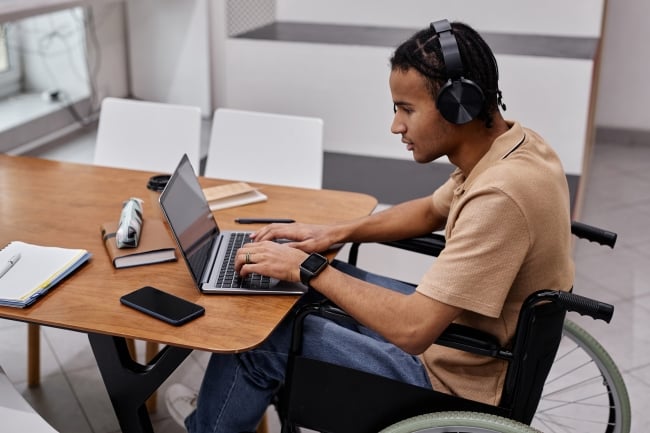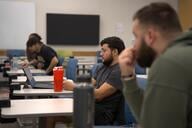You have /5 articles left.
Sign up for a free account or log in.

Students with disabilities say they prefer online courses, but there some considerations for providing accessible online education that staffers should keep in mind.
Seventy-Four/iStock/Getty Images
In 1990, the Americans With Disabilities Act gave students with disabilities the right to reasonable accommodations in higher education, but many colleges were not structured with disabled students in mind, creating systemic barriers to student success.
Prior research has found students with disabilities prefer online learning. Inside Higher Ed’s 2024 Student Voice survey, conducted by Generation Lab, found among students with a physical disability (n=197), 30 percent preferred online asynchronous courses. Those with a learning disability (n=254) preferred in-person or blended coursework.
Online education, when designed well, has the potential to promote access for students with disabilities as well as achievement and completion for these learners.
A recently published white paper by the Center for Higher Education Policy and Practice at Southern New Hampshire University (CHEPP) highlights obstacles in online education for students with disabilities and some of the ways institutions can aid disabled students’ educational pursuits.
More Reading
CHEPP’s paper is one of a series about learner-centered design in distance learning that provides insight and ideas for higher education practitioners looking to reform online education. The upcoming third paper will focus on the importance of belonging. Read more from the series here.
The background: Students with a disability are less likely to attend college, earn a degree and be employed full-time than their peers without a disability.
While colleges and universities continue to invest in programs and initiatives that uniquely serve students with disabilities, it is also important to make academics accessible to all kinds of learners.
“Higher education must make changes to increase college attainment for learners with disabilities by investing in robust accommodations and expanding accessible multimodal higher education program offerings with universal design for learning, among other impactful, evidence-based practices,” according to the report.
The COVID-19 pandemic and subsequent stay-at-home orders required higher education to shift course delivery online, which brought a renewed awareness to the challenges students with disabilities face, including gaps in technology and particularly a lack of online availability of student services such as accessibility offices. During this time, there was also an increase in students who registered with disability services for accommodations related to psychological disorders.
Starting with students in mind: Across higher education, students with disabilities are often left out of data gathering around persistence and completion, which hinders advocacy work, because there is less evidence of gaps in support.
“Instead of learners with disabilities being an afterthought, their needs should inform higher education design,” the report’s authors wrote. “When systems are built to serve all learners, they serve everyone better.”
The report points to the curb-cut effect as one example of when a physical accommodation—in this case, for people who use wheelchairs—can benefit more than just disabled people, such as those using strollers and bikes or others who needed help to access a sidewalk.
Many college students with disabilities are unaware of how to advocate for themselves in receiving accommodations, as well, which can lead to some students not registering with their college’s disability services or having accommodations that don’t meet all their needs. This lack of self-identification can further harm data collection and reporting that could be used to guide institutional priorities.
An accessible institution should focus on holistic student supports to provide learners with equitable agency, academic engagement and overall experience, according to the report. “In doing this, institutions will ensure that learners with disabilities have what they need to not only persist and complete their academic programs but also fully belong in their college communities alongside their peers, with and without disabilities.”
Enhancing access: The report pulls from interviews with practitioners, students and advocates as well as the available literature to offer six key elements of accessible online education.
- Transparent availability of resources and access to the disability office. A 2023 survey by Tyton Partners found just over half (56 percent) of students were aware of accessibility and disability services at their campuses, despite almost all (96 percent) administrators, advisers and faculty saying such support offices existed on their campus. Offices should aspire to proactively reach out to students prior to their first course, training staff on disability inclusion and making connections between students and professors to remove barriers. Easy access to and timely response from these offices can also promote student persistence and success. Frequent communication to the whole campus about available resources and clear messaging about how to contact the office can help bridge knowledge gaps.
- Universal design for learning principles embedded throughout course and program design and delivery. A UDL framework promotes learning among all student groups, because everyone learns differently. One example is implementing choice in assessment or providing additional time for students to complete a test. UDL can help reduce students’ needs for additional accommodations because the course is already focused on accessibility for all learners.
- Centralized systems and consistent use of technology across departments. In an online environment, providing a consistent student experience requires a single platform for students to access materials and course information, submit assignments and communicate with faculty and staff. When selecting new technologies, accessibility should be part of the criteria, as well.
- Continuous improvement processes and feedback channels. Students’ needs and disability status can change throughout their postsecondary experience, so institutions should establish a robust feedback channel that allows students to engage regularly with the disability services office and engage with faculty and staff about how accommodations are working.
- An institutional accessibility committee and governance policies. An oversight committee that meets regularly to evaluate compliance, receive feedback and ensure students’ needs are being met can help maintain a well-functioning disability service system. This committee could be a third party or various stakeholders throughout the institution representing different perspectives and departments.
- Regular engagement of faculty and student services professionals. Faculty members interact with students the most frequently and are often the implementers of accommodations for students with disabilities, requiring them to be proactive and responsive to needs. Institutional leaders can help support this work by providing resources to assess syllabi, ensuring materials are accessible or creating guidelines for a course.
We bet your colleague would like this article, too. Send them this link to subscribe to our weekday newsletter on Student Success.




